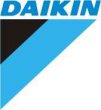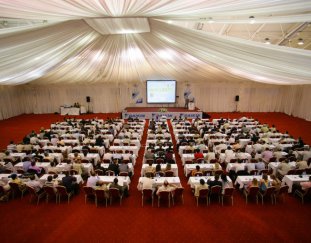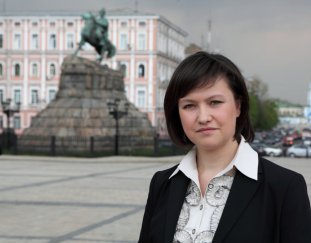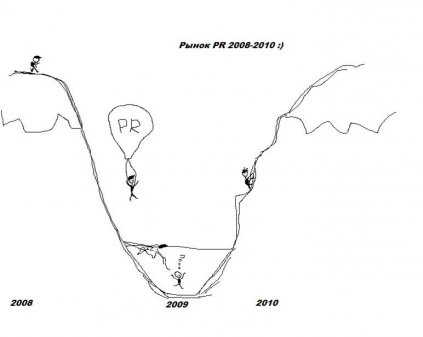The crisis touched Ukrainian PR-market same as many other industries and businesses. According to the Ukrainian PR-alliance in late 2008 the market was operated by 126 agencies and at the end of 2010 – 50 (out of which consistently work 20). What radical changes have taken place in the market? And how can PR-structures help both – customers and themselves?
Lessons from the crisis
We can distinguish three phases of the crisis on the Ukrainian PR-market:
1 - fall and decline (from autumn 2008 till 1-2 quarter 2009);
2 - when the market was “at the bottom” (in the summer of 2009 and up to 1st quarter of 2010);
3 - the beginning to come out of the crisis (starting with 2-3 quarter of 2010).
Events unfolded as follows. With the beginning of the crisis marketing and PR-budgets were sharply reduced and as a consequence were reduced staff marketing departments, especially Public Relations professionals in companies. Informational and PR-activities were decreased, which directly influenced the decline in outsourcing. Accordingly reductions influenced PR-agencies: large became averages, averages turned out to small and small simply ceased to exist.
PR-activities had been continued by only those companies who knew exactly what they need and who were confident with the effectiveness of their PR-instruments and in the partners with whom they were working.
On the other hand, without much loss come out only those PR-agencies that offered an effective crisis management strategies and had a margin of protection (first and foremost – loyal and new customers operated in different markets).
But those companies and agencies were quite a bit.
Experts note that the contradictory processes were observed at the PR-market and the crisis brought not only “cons”, but the “pros”.
“Many companies for the first time were turned to PR technologies right in time of crisis and came with their problems to the PR-agencies. Moreover, these companies are from completely different business lines of all sizes and geographic location” - says Valery Kureyko, CEO of Publicity Creating. “They are pragmatic, ambitious and open to new techniques, they value the reputation, experience and systematic approach, thus for the professional agencies it’s fairly easy to work with them” - he adds the finishing touches to a portrait of the “new customer”.
Among the positive trends can also be noted the revision to look on communications and PR as «art for art». These activities seem to be connected tightly with marketing results and performance requirements for communication programs were enhanced.
Some agencies have changed the priorities and instead of «training» (market, customers, employees) they focused directly on customers, increasing efficiencies, productivity and profitability.
But the main thing – communications market came out of the crisis completely different and for the successful work on it PR-agencies need to change fundamentally their approach. That’s why the topic of reengineering on the Ukrainian PR-market is a vital today.
Reengineering – what is it?
So, how did the term “reengineering” come out that is increasingly used by the media and how it is projected on the PR-industry?
The term “business process reengineering” was introduced in 1990 by the American Michael Martin Hammer. In the article “Reengineering of the traditional work methods: don’t automate – reject” he identified this activity as “a fundamental redesign of business processes for achieving dramatic improvement in critical areas of their performance: cost, quality, service and rates”.
As soon as every company needs a different kind of innovation, the reengineering for each of them will be defined in different way. The following types of reengineering are: fundamental, radical, dramatic (or jumping) and reengineering as a process.
A fundamental reengineering of the company provides answers to questions about the appropriateness of their current activities, ways of working and the company’s future. Thus should be reconsidered current rules and regulations of doing business, which are often irrelevant, outdated or even wrong.
Most innovative, however does not contain great risks, is a radical reengineering. Redesign based on this method involves changing the entire existing system, not just superficial changes. In case of a radical reengineering completely new ways of doing the work are offered.
The dramatic reengineering is appropriate only in emergency situations when you need to achieve a jump improve the performance of the company (in 500-1000% and more) by replacing old management techniques with new, because it contains a huge amount of risk.
Thus, the problem of reengineering is similar to the problems of innovation: the development of innovations to ensure competitiveness and, ultimately, the success of the enterprise.
The main rule of reengineering – “Start with a clean sheet”
Reengineering is not «reset» (how is often said in business surroundings), but the creation of an entirely NEW system of coordinates. Rebooting we avoid the «failures», but we are returned to the same operating system as before simply restarting it. The result of reengineering is a totally new system.
PR Communications: changes in all areas
Reengineering is rarely happens accidently. Usually companies and entire industries are forced to resort to reengineering not because of “a good life”. In this case, the forerunner of reengineering for PR-industry in Ukraine was not only a world economic crisis (in Ukraine it was mainly economical and political), but also dramatic changes in the channels of communication. These factors have led to a number of changes that are reflected in four main areas:
1. Products and services.
In connection with the development of the Internet and social networking, there are no more PR-products based on «pure» off-line. Traditional PR events, press events and other forms are, as a minimum, maintained and supported by the Internet.
In general, the activities are increasingly moving to online in various forms: besides the already familiar text and photos, it is also a videos (from the corporative to the viral) and discussion (from communicating on forums, corporate blogs to the online consultations).
In such case, «clean» online (without the off-line forms) or «dialogue for the sake of communication» in social networks don’t bring the marketing results to commercial structures.
2. Schemes of work.
The main trend – companies are trying to communicate «directly» with consumers and this is possible via the Internet and at events. The role of traditional media as a channel of PR-communications goes down, especially if to talk about the print media business.
Professional agencies today are different that follows:
- Integration of off-line and online forms, their «weaving» and mutually reinforcing;
- More multi-tasking and a variety of solutions;
- More and more customized programs for clients;
- Optimization of approaches, more flexible scheduling, more «subtle» ways of organizing, against the backdrop of tightening discipline and increasing the intensity of work, and as a consequence -
- “New prices” - PR has become more accessible to a wide range of clients.
3. Staff and personnel.
In response to the crisis, which was accompanied by reduced budgets, freezing of marketing and communications activities and as a result of a substantial decrease in the number of orders, PR-branch was left by up to 50-60% of the specialists. Of the remaining 40% of them on market, only half actually worked during the crises of 2008 and 2010. The other half was «outlasting», «waiting a». Thus, now there is a problem with personnel.
Returning to the market those, who were «waited a» during the crisis or even left the industry in the crisis years does not correct the situation. These people have lost their skills and can not solve problems in new environments, because of major changes that have occurred in the market during this time. For the young and novice professionals (for example, last-year students of profile high schools) it’s still very difficult to find a “place under the sun”, because of shortage of structures that really work and moreover are developing, as a consequence - a shortage of open positions.
4. Clients.
Customers also have become “differ” - the new in the direct and figurative sense. Firstly they require more, but for less money. Secondly they think mainly tactically not strategically. They expect an active influence on the communication component of their market positions. New customers expect from the agencies predictable results and a proactive policy, relations at the level of “partner-partner” rather than “client-contractor” or “principal-agent”.
Results and the role of top management
As soon as reengineering requires a radical restructuring of business processes, pricing policies, organizational structure, the central role in it should play leaders and senior managers. Top management may encounter many difficulties along the way, but the results are worth it.
“We realized the need for change at the beginning of the crisis and at the beginning of 2010 started to work actively. Reengineering touched many aspects of the company – from positioning to pricing, from organizational structure to corporate standards... This is not an easy process, but it gives its results: in the current year, the number of customers and orders have increased by almost 2.5 times, in that order revenues were increased, the team was expanded and refreshed” - says Valery Kureyko.
Since 2009 the Publicity Creating works in the area of Internet PR, now it is increasing. The particular attention is given to video and social networking. PR-department and customer-service group are also increased. In this case, the functions of managers have changed as the standards (for instance, the deadlines of the most papers are much shorter, reporting forms are more responsive and intuitive). The value of analytics, research, interviews increases too. The scheme of work with the media and the general approach to press events changed significantly.
"But the most importantly – the agency became a customer-oriented. In fact, the only audience we are interested in today – our clients and customers of our clients. We are working for them” - said the head of Publicity Creating.
It can be predicted that in 2011 it will be a period of active coming out of the crisis and on the PR market it will be finally formed a new, more efficient and modern system of coordinates, which will affect communication channels, products and methods of work. This new system will allow further development of agencies, clients, and the market as a whole.
Prepared by Yulia Skoroda


















![/images/mod_banners/teva[2].jpg /images/mod_banners/teva[2].jpg](/images/mod_banners/teva[2]_zoom_width_145_height_110.jpg)
![/images/mod_banners/abbyy_logo_300dpi_7812[1].jpg /images/mod_banners/abbyy_logo_300dpi_7812[1].jpg](/images/mod_banners/abbyy_logo_300dpi_7812[1]_zoom_width_145_height_110.jpg)
![/images/mod_banners/lazolvan[1].jpg /images/mod_banners/lazolvan[1].jpg](/images/mod_banners/lazolvan[1]_zoom_width_145_height_110.jpg)
![/images/mod_banners/29[1].jpg /images/mod_banners/29[1].jpg](/images/mod_banners/29[1]_zoom_width_145_height_110.jpg)
![/images/mod_banners/Korporaciya_20Bogdan_1[1].jpg /images/mod_banners/Korporaciya_20Bogdan_1[1].jpg](/images/mod_banners/Korporaciya_20Bogdan_1[1]_zoom_width_145_height_110.jpg)
![/images/mod_banners/vitmark[1].jpg /images/mod_banners/vitmark[1].jpg](/images/mod_banners/vitmark[1]_zoom_width_145_height_110.jpg)

![/images/mod_banners/i[3].jpg /images/mod_banners/i[3].jpg](/images/mod_banners/i[3]_zoom_width_145_height_110.jpg)
![/images/mod_banners/lenovolockup_pos_color[1].jpg /images/mod_banners/lenovolockup_pos_color[1].jpg](/images/mod_banners/lenovolockup_pos_color[1]_zoom_width_145_height_110.jpg)

![/images/mod_banners/42975-hi-Avon_Logo[1].jpg /images/mod_banners/42975-hi-Avon_Logo[1].jpg](/images/mod_banners/42975-hi-Avon_Logo[1]_zoom_width_145_height_110.jpg)
![/images/mod_banners/skoda[1].jpg /images/mod_banners/skoda[1].jpg](/images/mod_banners/skoda[1]_zoom_width_145_height_110.jpg)





_zoom_311x243.jpg)

